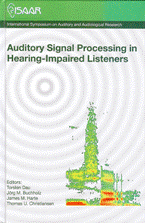Auditory brainstem responses elicited by embedded narrowband chirps
Abstract
Auditory brainstem responses (ABRs) have been investigated using rising frequency chirps to compensate for the dispersion along the cochlear partition in the auditory periphery. Responses elicited by the broadband chirp show larger wave-V amplitude than do click-evoked responses for most stimulation levels (Dau et al., 2000). It is desirable in some clinical (objective audibility assessment) and research (cochlear latency estimation, Neely et al., 1988) applications for more frequency specific responses. Traditionally, this has been accomplished using tone-burst stimuli, however these have the problem of spectral splatter associated with temporally short narrowband stimuli. Conceivably one could use narrowband chirps to synchronise a small number of auditory filters, and thereby gain frequency speci city. However, similar to the tone-burst ABRs, the stimulus duration would be very short, and therefore onset and offset effects will result in spectral splatter and thus degrade the frequency speci city. Junius and Dau (2005) showed that, by embedding a single broadband rising chirp, spectrally and temporally in two steady-state tones, the effects of spectral splatter along the cochlear partition can be minimised. Further, by ensuring that the excitation level is sufficiently low, one can keep any steady state responses in the evoked potential to a minimum. This paper presents a feasibility study in the use of embedded narrowband chirp stimuli to obtain frequency specific auditory brainstem responses, for use in clinical and research settings.
References
Dau, T., Wegner, V., and Kollmeier, B. (2000). “Auditory brainstem responses with optimized chirp signals compensating basilar-membrane dispersion,” J. Acoust. Soc. Am. 107, 1530-1540.
de Boer, E. (1980). “Auditory physics. Physical principles in hearing theory I,” Phys. Rep. 62, 87-174.
Debruyne, F., and Forrez, G. (1982). “On-effect in brainstem electric response audiometry,” Otolaryngology 44, 36-42.
Gorga, M.P. and Thornton, A.R. (1989). “The choice of stimuli for ABR measurements,” Ear Hear., 10, 217-230.
Hecox, K., Squires, N., and Galambos, R. (1976). “Brainstem auditory evoked responses in man. I. Effect of stimulus rise-fall time and duration,” Electroencephalogr. Clin. Neurophysiol. 53, 652-657.
Junius, D., and Dau, T. (2005). “Influence of cochlear travelling wave and neural adaptation on auditory brainstem responses,” Hear. Res. 205, 53-67.
Kodera, K., Yamane, H., and Suzuki, J. (1977). “The effect of onset, offset and rise- decay times of tone bursts on brainstem response,” Scand. Audiol. 6, 205-210.
Moore, B. C. J. (1986). “Parallels between frequency selectivity measured psychophysically and in cochlear mechanics,” Scand. Audiol. 25, 139-152.
Neely, S. T., Norton, S. J., Gorga, M. P., and Jesteadt, W. (1988). “Latency of auditory brain-stem responses and otoacoustic emissions using tone-burst stimuli,” J. Acoust. Soc. Am. 83, 652-656.
Riedel, H., Granzow, M. and Kollmeier, B. (2001). “Single-sweep-based methods to improve the quality of auditory brainstem responses. Part II: Averaging methods,” Z. Audiol. 40, 62-85.
Shera, C., Guinan, Jr., J. J., and Oxenham, A. J. (2002). “Revised estimates of human cochlear tuning from otoacoustic and behavioural measurements,” P.N.A.S. 99, 3318-3323.
Tsuji, J., and Liberman, M. C. (1997). “Intracellular labelling of auditory nerve fibres in guinea pig: Central and peripheral projections,” Jnl. of Comparative Neurol. 381, 188-202.
Úlehlová, L. Luboš, V., and Janisch, R. (1987). “Correlative study of sensory cell density and cochlear length in humans,” Hear. Res. 28, 149-151.
Van Campen, L. E., Hall, J. W., and Grantham, D. W. (1997). “Human offset auditory brainstem response: Effects of stimulus acoustic ringing and rise-fall time,” Hear. Res. 103, 35-46.
van der Drift, J. F. C., Brocaar, M. P., and van Zanten, G. A. (1988a). “Brainstem response audiometry. I. Its use in distinguishing between conductive and cochlear hearing loss,” Audiol. 27, 260-270.
van der Drift, J. F. C., Brocaar, M. P., and van Zanten, G. A. (1988b). “Brainstem response audiometry. II. Classi cation of hearing loss by discriminant analysis,” Audiol. 27, 271-278.
Wegner, O., and Dau, T. (2002). “frequency speci city of chirp-evoked auditory brainstem responses,” J. Acoust. Soc. Am. 111, 1318-1329.
Additional Files
Published
How to Cite
Issue
Section
License
Authors who publish with this journal agree to the following terms:
a. Authors retain copyright* and grant the journal right of first publication with the work simultaneously licensed under a Creative Commons Attribution License that allows others to share the work with an acknowledgement of the work's authorship and initial publication in this journal.
b. Authors are able to enter into separate, additional contractual arrangements for the non-exclusive distribution of the journal's published version of the work (e.g., post it to an institutional repository or publish it in a book), with an acknowledgement of its initial publication in this journal.
c. Authors are permitted and encouraged to post their work online (e.g., in institutional repositories or on their website) prior to and during the submission process, as it can lead to productive exchanges, as well as earlier and greater citation of published work (See The Effect of Open Access).
*From the 2017 issue onward. The Danavox Jubilee Foundation owns the copyright of all articles published in the 1969-2015 issues. However, authors are still allowed to share the work with an acknowledgement of the work's authorship and initial publication in this journal.


